Florida Trees and Shrubs
Varnishleaf, Dahoon Holly, Southern Magnolia, Loblolly Bay, Wax myrtle, Sweet Bay, Florida Rapanea, Tarflower, Strawberry Guava, Sea Hibiscus, Portia Tree, Sapodilla Tree
Hop bush - Dodonaea viscosa
Family - Sapindaceae
Native
_small.jpg)
_small.jpg)
Habitat - Coastal Strand, Coastal Hammocks
Description - Native small tree or more commonly a shrub to 10 feet high, occasionally taller. Leaves alternate, obovate, shiny yellowish-green and sticky, 3-6 inches long.
Flower - Yellowish-green in small terminal clusters, followed by green to pinkish winged capsules.
Dahoon Holly - Ilex cassine
Family - Aquifoliaceae
Native


Habitat - Bay swamp, hardwood swamp, margins of wet prairies and marshes.
Description - Native evergreen shrub or tree, may grow to nearly 40 feet in height although it's usually smaller. Leaves are 1 1/2 to 3 inches in length, wider toward the tip (obovate) the margins of most, but not all leaves have a few small teeth with a small bristle at the tip. White flowers are in clusters and are inconspicuous.
Fruit is a spherical red or yellow berry1/4 inch in diameter and is an important wildlife food source, especially for migrating song birds, native quail and wild turkey.
Southern Magnolia - Magnolia grandiflora
Family - Magnoliaceae
Native
%20flower%20_small.jpg)
%20_small.jpg)

Habitat - Primarily bottomland forests and Mesic upland woodlands. Southern Magnolia is widely used as a landscape tree.
Description - Native evergreen tree 60-80 feet in height, simple leaves are alternately arranged, elliptic to oval in shape with entire margins, dark shiny green above, rusty brown pubescent on lower surface and to 8 inches in length. Fragrant large white, or creamy white flowers to 8 inches across. Fruit is called a burr, it is cone-like in appearance with red berries in autumn that hang from silken threads.
Loblolly Bay - Gordonia lasianthus
Family - Theaceae
Native
Habitat - Swamps, bogs, wet flatwoods, bay galls
Description - Native evergreen tree to 60-70 feet in height with a narrow conical crown. Leaves are dark green, alternate, oblong shape with lightly serrate to crenate margins, 2 1/2 to 6 inches long.
Flower - Fragrant white or creamy white, 2-3 inches across, cup shaped with 5 petals surrounding numerous golden-yellow stamens. Begins flowering in May-June and flowers throughout the summer.
Wax myrtle - Myrica cerifera
Family - Myricaceae
Native
_small.jpg)
_small.jpg)
Habitat - Margins of swamps, lakes, ponds and creeks, wet prairie, pinelands, hardwood forests.
Description - Wax myrtle is a common Florida native that grows as a shrub or a small tree to about 30 feet, preferring moist sandy soil.
Widely used as a landscape plant for an accent or informal screening plant. Leaves are alternate, 4-5 inches long, have a waxy upper surface and are pleasantly aromatic when crushed.
Wax myrtle's small bluish berries are an important wildlife food source and it is a larval host plant for red-banded hairstreak butterfly which deposit their eggs on dead, fallen leaves. Wax myrtle is moderately drought resistant
Sweet Bay - Magnolia virginiana
Family - Magnoliaceae
Native
_small.jpg)
_small.jpg)
Habitat - Swamps, Low lying forests & floodplains on rich, wet acidic soils.
Description - Native tree with a 40 to 60 foot average height, often with multiple trunks. Sweet Bay is deciduous in colder regions and evergreen in milder climates.
Bark is fairly smooth and grayish in color. Leaves are simple with entire margins, elliptic shape, dark green on upper surface and silvery green underneath.
Flowers produced in summer are white, cup shaped and fragrant. Fruit is a hard burr, seeds are bright red and are consumed by birds and animals alike. Sweet Bay Magnolia is also a butterfly host plant.
Myrsine - Rapanea punctata
Family - Myrsinaceae
Native


Habitat - Coastal hammocks & moist pinelands on the panhandle.
Shrub or small tree to 20 feet plus, distinguishing characteristics are the flowers that are produced directly on the stems of the previous years growth, also the alternately arranged dark green, leathery leaves that are bunched together at the ends of the branches. Fruit is a tiny dark blue or black berry, present nearly year-round.
Tarflower - Bejaria racemosa
Family - Ericaceae
Native
_small.jpg)
Habitat - Common medium to large native shrub of Flatwoods & Scrub habitat, on a variety of soil types.
Description - Native drought tolerant perennial shrub, 4 to 8 feet tall with stiffly upright branches. Leaves are 1 to 2 inches long, 1/4 inch to 1 inch wide, with a waxy upper surface and entire margins and curled or with wavy margins.
Flower - Conspicuous, fragrant white & pink flowers are produced from the spring through fall, fruit is a round capsule. Both flowers and fruit are sticky and frequently trap insects, a trait which gives this shrub its common names. Butterflies feed on nectar.
Strawberry Guava - Psidium cattleianum
Family - Myrtaceae
Invasive / Exotic
_small.jpg)
%20leaf_small.jpg)
Habitat - Escapes from cultivation into wet areas.
Description - Category I invasive plant. Small tree or large shrub to 25 feet tall, grey to reddish-brown peeling bark, leaves are opposite with entire margins, elliptic to oblong shaped to 3 inches long.
Flower - Single white flowers produced from leaf axils, are just over 1 inch wide with many white and yellow stamens. Fruit is a purplish-red globose berry to about 2 1/2 inches long containing many seeds.
Sea Hibiscus- Hibiscus tiliaceus
Family - Malvaceae
Invasive / Exotic
%20_small.jpg)
2%20_small.jpg)
Habitat - Ruderal, coastal areas, roadsides
Description - Not native, category 2 exotic plant. Large shrub, small tree to 25 feet in height with a spreading habit of growth. Leaves are alternate, broadly cordate with pubescent lower surface.
Flower - Hibiscus type flower, yellow at opening and turning reddish-orange by days end.
Portia Tree, Seaside Mahoe, Milo - Thespesia populnea
Family - Malvaceae (Hibiscus)
Invasive / Exotic
Found from the Keys northward to Tampa Bay on the west coast and to Brevard county on the east coast where freezing temperatures prevent its northward spread. Often associated with mangroves growing on sandy shores of estuaries.
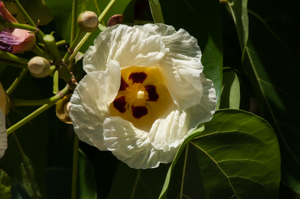
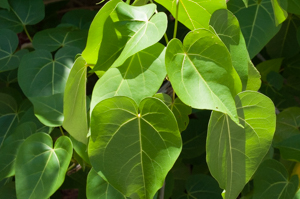
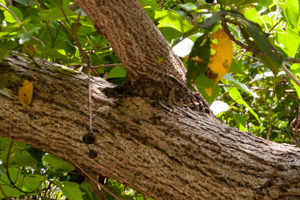
May grow as a large shrub or a tree, to 30 ft. tall with a trunk up to 12 inches in diameter. Bark is a light brown/tan color becoming fissured with age, younger branches are smooth and minutely scaled. Leaves are shiny green above, cordate (heart shaped), 2-8 inches long.
Flowers produced almost year-round in S. Florida are 2-3 inches across, pale yellow with a maroon center, five petals and turn purple and wilt by the end of the day. Fruit is a leathery flattened black capsule containing several hairy brown seeds, the capsules and seeds are bouyant allowing for efficient dispersal by water currents and tides.
Sapodilla Tree - Manilkara zapota
Family - Sapotaceae
Invasive / Exotic
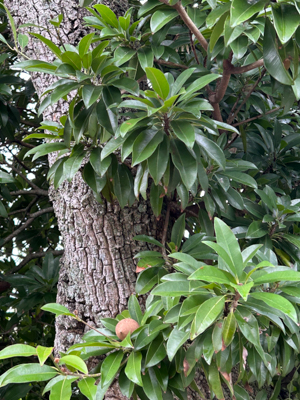
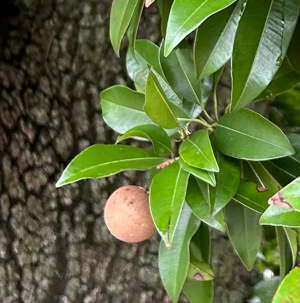
Sapodilla is native to the West Indies, Mexico and the Central America region. Originally cultivated for its fruit, it spread to natural areas where it is very well adapted to the growing conditions in South Florida. Seeds are spread by raccoons and other small mammals that eat the fruit, seedlings form dense thickets crowding out native species. Growing to 60 plus feet Sapodilla is an invasive tree in South and Central Florida.
Large evergreen tree up to 60 to 100 feet tall with a 40 foot spread and a thick trunk, bark is thick, grey and furrowed when older, younger branches are hairy, brownish. Leaves are up to 5 inches long, alternate, a medium to lighter green and are usually clustered at the ends of the branches.
Flowers are small ( 5 mm ), white and tubular with 6 lobes, fruit is brown with crusty skin, 3 +/- inches in diameter.